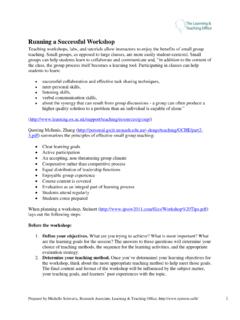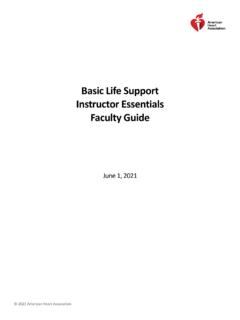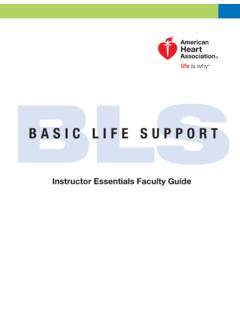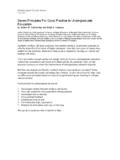Transcription of Engaging Adult Learners - Ryerson University
1 Prepared by Michelle Schwartz, Instructional Design and Research Strategist, for the Learning & Teaching Office, 1 Engaging Adult Learners The population of students pursuing higher education in Canada is changing. According to an article in Academic Matters: Undergraduates in Canada and the are studying less, working more, and taking longer to complete their Just one quarter of University students today follow the path of the traditional, full-time, residential undergraduate (Steele, 2010). These non-traditional students are usually older, and may have different commitments or priorities than younger students. They may be taking night classes because they work during the day, or they may be trying to enter a new field mid-career. When teaching a course with a population of non-traditional students, keep in mind some characteristics unique to Adult Learners : 1. Adult learning is selective. This means that adults learn will learn what is meaningful for them.
2 They are not very inclined to learn something they are not interested in, or in which they cannot see the meaning and importance (Rubenson, 2011, p. 49). 2. Adult learning is self-directed. Adults take responsibility for their own learning. Malcolm Knowles defined self-directed learning as a process by which people identify their learning needs, set goals, choose how to learn, gather materials, and evaluate their progress (Rubenson, 2011, p. 53). 3. Many Adult Learners have been away from formal schooling for many years, and may have had negative experiences with school. These Adult Learners may be reentering schooling with anxiety and low self-esteem (Rubenson, 2011, p. 53). 4. Conversely, Adult Learners also bring years of previous knowledge and experience to the classroom, as well as an established system of values and beliefs governing their thought (Jarvis, 2004, p. 144). They expect to be treated as adults. 5. Adults often have a problem-centered approach to learning, and are interested in content that has a direct application to their lives.
3 They want to see immediately how the course content is relevant to their current problems or situations (Rochester Institute of Technology). The impact of these characteristics on student learning is not limited to the face-to-face classroom. These characteristics also affect the way that Adult Learners will approach learning in the online environment as well (Milheim, 2011). For example, in a study of Adult Learners in the United States, the most highly rated design elements in a blended online learning environment were those that provided personal relevance in what they learn, participation in setting their learning outcomes based on their real-world needs, self-direction of their learning resources and pathways, and establishment of an active learning community (Ausburn, 2004, as cited in Cornelius et al., 2011). Effective Teacher Characteristics When teaching Adult Learners , there is a shift in the relationship between faculty member and students, and a shift in the way that Learners will perceive the effectiveness of different teaching methods (Karge et al, 2011).
4 Hill has defined three areas where Adult Learners have identified specific teacher traits that they found beneficial to their learning (2014). These three areas are teaching competencies, relationships with students, and teacher attitudes. 1. Teacher competencies included having relevant practice knowledge providing relevant, real time information and teaching practice applications as well as theory and teaching material that is up-to-date and evidence based. Adult Learners were appreciative of instructors who were able to structure classroom learning, implement a variety of teaching techniques, and stimulate discussion. They Prepared by Michelle Schwartz, Instructional Design and Research Strategist, for the Learning & Teaching Office, 2 expected instructors to follow the syllabus, and had very little patience for instructors that were unprepared for class. 2. In forming relationships with their instructors, Adult Learners valued instructors who were approachable and available, and were flexible both in regard to deadlines and class activities.
5 They found it important that instructor value and validate their experience, as well as be sympathetic to the demands placed on them by jobs and family. 3. With regard to teacher attitude, Adult Learners appreciated instructors who were fun and enthusiastic and who listened to students, viewed students as having knowledge and didn t treat them like blank slates. (Hill, 2014) Keillor and Littlefield (2012) have developed the following list of best practices for promoting an Adult s readiness to learn. 1. Create a safe, welcoming learning environment 2. Create a culture of empathy, respect, approachability, authenticity 3. Collaborate on the diagnosis of learning needs 4. Collaborate on developing learning objectives and in instructional planning 5. Ensure the practicality of all learning activities When teaching students who may have had little experience of formal education, or are returning to school after a long break, Lee Bash stresses the importance of creating a link between the world the Adult knows and the academy he or she is about to enter.
6 1. Introduce and orient new students to the specific institution and what makes it distinctive for Adult Learners . 2. Help the students make adjustments to college-level work while preparing them for some of the potential problems they are likely to encounter as Adult Learners . 3. Prepare the student for the responsibilities they are about to assume and understand what faculty members typically seek in good students (Bash, 2003, p. 161). Effective Teaching Methods to Support Adult Learning Jarvis and Rubenson have identified some over-arching concepts governing good teaching methods for Adult Learners . 1. Teachers should facilitate learning. They should create the environment in which learning occurs, and guide the students through the learning process; however, they should not dictate the outcome of the experience. They may seek to create an awareness of a specific learning need in the students; to confront students with a problem requiring a solution; to provide the students with an experience and encourage reflection on it (Jarvis, 2004, p.)
7 153) 2. Teachers should provide autonomy and independence. This can mean the freedom of pace, choice, method, content, or assessment. For instance, students should be free to work at their own speed, choose to study particular aspects of a course , choose to study particular aspects of a course , adopt whatever learning style suits them best, and be free to choose what they learn (Jarvis, 2004, p. 154). 3. Teaching should empower Learners . As a corollary to the need to provide autonomy and independence, teachers should share power and decision-making roles with their students. Teachers should avoid being in the position of providing right answers. They should make sure that there is equal access to all resources, include self-evaluation in graded courses, involve students in managing Prepared by Michelle Schwartz, Instructional Design and Research Strategist, for the Learning & Teaching Office, 3 the learning environment, and be open and explicit about what is happening and why (Rubenson, 2011, ).
8 There are many specific teaching methods that can be used to support Adult learning. These methods can be divided into five categories: self-directed, active, experiential, collaborative, and narrative. Self-Directed Self-directed learning is independent it provides the learner with the ability to make choices, to take responsibility for their own learning, and the capacity to articulate the norms and limits of learned society, and personal values and beliefs (Goddu, 2012). In self-directed learning, the instructor shifts from the leader of the learning experience to the facilitator of learning, becoming a source to be tapped, as required by the learner (Robotham 1995, as cited in Goddu 2012). Self-directed learning provides students with the opportunity and freedom to choose the means of acquiring knowledge that is best suited to them based on their own self-knowledge (Alex et al., 2007). In online or blended environments, self-directed learning can be offered through the creation of dynamic learning environments where students may go beyond content presented by the instructor to explore, interact with, comment on, modify, and apply the set content and additional content they discover or create through the learning process (LeNoue, 2011).
9 Active Active learning provides students with opportunities to enhance skills, improve their critical thinking, and gain knowledge in an efficient way (Karge et al., 2011). Active learning provides students with opportunities to apply their own background knowledge or prior experience, and instructors with the opportunity to assess existing student knowledge: Didactic Teaching A didactic approach can be very effective when used to encourage students to analyze the course content rather than just learn it by rote. This can be done by encouraging Learners to ask questions, thus initiating the learning process themselves. Further, if a student asks a question to which the teacher doesn t know the answer, Jarvis stresses the importance of asking the class if anyone knows the answer, and then suggesting students go out and find the answer themselves. When a teacher admits to not knowing the answer and trusting the students to be able to figure it out, this demonstrates a respect for the students knowledge and experience, as well as facilitating their independent learning (Jarvis, 2004, p.)
10 150). Socratic Teaching The Socratic method introduces questioning into the teaching and learning process; it consists of the teacher directing a logical sequence of questions at the Learners , so that they are enabled to respond and to express the knowledge that they have, but which they might never have crystallized in their own mind. The Socratic method is an effective method to employ when teaching adults because it: o utilizes both their store of knowledge and their experience of life o help the Learners create rather than reproduce knowledge o actively engage Learners in the learning process (Jarvis, 2004, p. 151). Problem Based Learning: In PBL, learning is both active and self-directed. Students are provided with a real life situation or problem and some guidelines on how to solve the problem. The distinctive feature of problem-based learning, and the one that makes it so well suited to Adult Learners , is the focusing of the learning process on the identification, exploration, and attempted resolution of Prepared by Michelle Schwartz, Instructional Design and Research Strategist, for the Learning & Teaching Office, 4 realistic problems (Tight, 2003, p.










